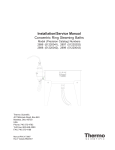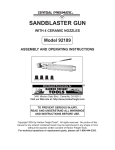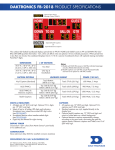Download C2 Horizontal Electrophoresis System
Transcript
Horizontal Electrophoresis System Model C2 Operating and Installation Manual 7217451 Rev. 0 Visit us online to register your warranty www.thermoscientific.com/warranty Preface MANUAL NUMBER 7217451 0 -- 4/9/12 Transferred to Marietta (was 11/2002) ccs REV ECR/ECN DATE DESCRIPTION By Thermo Scientific Horizontal Electrophoresis System i Preface Important Read this instruction manual. Failure to read, understand and follow the instructions in this manual may result in damage to the unit, injury to operating personnel, and poor equipment performance. s Caution All internal adjustments and maintenance must be performed by qualified service personnel. s Material in this manual is for information purposes only. The contents and the product it describes are subject to change without notice. Thermo Fisher Scientific makes no representations or warranties with respect to this manual. In no event shall Thermo be held liable for any damages, direct or incidental, arising out of or related to the use of this manual. ©2012 Thermo Fisher Scientific. All rights reserved. ii Horizontal Electrophoresis System Thermo Scientific Preface Important operating and/or maintenance instructions. Read the accompanying text carefully. Potential electrical hazards. Only qualified persons should perform procedures associated with this symbol. Equipment being maintained or serviced must be turned off and locked off to prevent possible injury. Hot surface(s) present which may cause burns to unprotected skin, or to materials which may be damaged by elevated temperatures. Marking of electrical and electronic equipment, which applies to electrical and electronic equipment falling under the Directive 2002/96/EC (WEEE) and the equipment that has been put on the market after 13 August 2005. This product is required to comply with the European Union’s Waste Electrical & Electronic Equipment (WEEE) Directive 2002/96/EC. It is marked with the WEEE symbol. Thermo Fisher Scientific has contracted with one or more recycling/disposal companies in each EU Member State European Country, and this product should be disposed of or recycled through them. Further information on Thermo’s compliance with this directive, the recyclers in your country and information on Thermo products will be available at www.thermofisher.com. 4 Always use the proper protective equipment (clothing, gloves, goggles, etc.) 4 Always dissipate extreme cold or heat and wear protective clothing. 4 Always follow good hygiene practices. 4 Each individual is responsible for his or her own safety. Thermo Scientific Horizontal Electrophoresis System iii Preface Do You Need Information or Assistance on Thermo Scientific Products? If you do, please contact us 8:00 a.m. to 6:00 p.m. (Eastern Time) at: 1-740-373-4763 1-800-438-4851 1-877-213-8051 http://www.thermoscientific.com [email protected] www.unitylabservices.com Direct Toll Free, U.S. and Canada FAX Internet Worldwide Web Home Page Tech Support Email Address Certified Service Web Page Our Sales Support staff can provide information on pricing and give you quotations. We can take your order and provide delivery information on major equipment items or make arrangements to have your local sales representative contact you. Our products are listed on the Internet and we can be contacted through our Internet home page. Our Service Support staff can supply technical information about proper setup, operation or troubleshooting of your equipment. We can fill your needs for spare or replacement parts or provide you with on-site service. We can also provide you with a quotation on our Extended Warranty for your Thermo Scientific products. Whatever Thermo Scientific products you need or use, we will be happy to discuss your applications. If you are experiencing technical problems, working together, we will help you locate the problem and, chances are, correct it yourself...over the telephone without a service call. When more extensive service is necessary, we will assist you with direct factory trained technicians or a qualified service organization for on-the-spot repair. If your service need is covered by the warranty, we will arrange for the unit to be repaired at our expense and to your satisfaction. Regardless of your needs, our professional telephone technicians are available to assist you Monday through Friday from 8:00 a.m. to 6:00 p.m. Eastern Time. Please contact us by telephone or fax. If you wish to write, our mailing address is: Thermo Fisher Scientific 401 Millcreek Road, Box 649 Marietta, OH 45750 International customers, please contact your local Thermo Scientific distributor. iv Horizontal Electrophoresis System Thermo Scientific Table of Contents Thermo Scientific Section 1 Safety Information/ Introduction . . . . . . . . . . . . . . . . . . . . . . . . . . . . . . .1-1 Introduction . . . . . . . . . . . . . . . . . . . . . . . . . . . . . . . . . . . . . . . . . . . .1-1 Section 2 Unpack and Check Your Order . . . . . . . . . . . . . . . . . . . . . . . . . . . . . . . . .2-1 Section 3 Setting Up . . . . . . . . . . . . . . . . . . . . . . . . . . . . . . . . . . . . . . . . . . . . . . . . . . .3-1 Section 4 Using the System . . . . . . . . . . . . . . . . . . . . . . . . . . . . . . . . . . . . . . . . . . . . .4-1 Finishing Up . . . . . . . . . . . . . . . . . . . . . . . . . . . . . . . . . . . . . . . . . . .4-2 Section 5 Care and Cleaning . . . . . . . . . . . . . . . . . . . . . . . . . . . . . . . . . . . . . . . . . . . .5-1 Section 6 Reagents Information . . . . . . . . . . . . . . . . . . . . . . . . . . . . . . . . . . . . . . . . .6-1 Section 7 Troubleshooting . . . . . . . . . . . . . . . . . . . . . . . . . . . . . . . . . . . . . . . . . . . . . .7-1 Horizontal Electrophoresis System v Safety Information/ Introduction Section 1 Please read carefully before operating! Warning To avoid the risk of personal shock, always disconnect the gel box from the power supply. Further, the power supply must be equipped with a shut-downon- disconnect circuit. Do not move the unit unless the power source to the unit has been disconnected. Statement of Proper Use: Use this product only for its intended purpose as described in this manual. Do not use this product if the power leads are damaged or if any of its surfaces are cracked. Introduction Thermo Scientific The Microgel Electrophoresis System is designed for quick restriction fragment analysis. Glass slides with dimensions of 2 x 3” are used as the gel tray. Thin gels may be poured and formed by surface tension. A caster is also available for thicker individual gels. The system also comes with a 7tooth comb and the power cords necessary for running the unit. Horizontal Electrophoresis System 1-1 Unpack and Check Your Section 2 Order Before getting started, unpack the unit and inventory your order. If any parts are missing, refer to the enclosed information sheet regarding returns and exchanges and contact Technical Services immediately. Reference the order or catalog number on your invoice and check the corresponding parts list: Part No. . . . . . . . . . . . . . . . . . . . . . . . . .Description C2-S . . . . . . . . . . . . . . . . . . . . . . . . .Buffer Chamber PSL-5 . . . . . . . . . . . . . . . . . . . . .Power Supply Leads C2-CST . . . . . . . . . . . . . . . . . . . . .Casting Chamber C-GS . . . . . . . . . . . . . . . . . .Casting Slides, pk of 10 C2-7D . . . . . . . . . . . . . . .Comb:7 well, 1.5mm thick Lid Power Supply Leads Buffer Chamber Gel Casting Tray Comb (1) Slides (10) Figure 2-1. Exploded Parts Drawing Thermo Scientific Horizontal Electrophoresis System 2-1 Section 2 Unpack and Check Your Order Basic Specifications and Recommended Running Conditions - Model C2 Gel size (W x L cm): . . . . . . . . . . . . . . .2” W x 3” L Buffer Capacity (ml): . . . . . . . . . . . . . . . . . . . . . .100 Voltage Requirements (V): . . . . . . .20-70, 30 average 2-2 Horizontal Electrophoresis System Thermo Scientific Section 3 Setting Up Casting Gels 1. A 2 x 3” slide fits into the casting system. A package of 10 is included in the complete system. These slides are also available from Technical Services, part # C-GS. 2. Prepare agarose solution. Pour the gel. Figure 3-1. Slide a. Preparing the gel - Using electrophoresis grade agarose and compatible electrophoresis buffer, the gel may be prepared in various ways. The percentage of agarose and the electrophoretic buffer used is determined by the size of the samples to be separated and further recovery of the samples (see Section 6). The agarose and buffer are mixed and heated over a heat source, in a microwave oven, or in an autoclave until the agarose is completely dissolved. The prepared gel then must be cooled to below 60° before casting to avoid warping the caster due to excessive heat. If numerous gels are to be run in one day, a large volume of gel may be prepared and placed in a covered bottle stored between 40-60° in a water bath. This provides a ready gel supply in a warm liquid form that will solidify quickly when gels are cast. For further tips on sample preparation and visualization, see Section 6. 3. Pour 12ml of gel solution into the casting unit. 4. Place comb into slot provided on walls of caster. A 7-tooth comb for 2” wide gels is available from Technical Services, part # C2-7D. 5. Allow gel 15 minutes to solidify and remove comb. Figure 3-2. Comb 6. To remove glass slide and gel from caster, simply place finger into hole. Figure 3-3. Finger Hole Thermo Scientific Horizontal Electrophoresis System 3-1 Section 3 Setting Up Casting Gels (continued) 7. Place the glass slide on the platform of the Microgel unit. Add running buffer and load samples into wells. Figure 3-4. Slide on Platform 3-2 Horizontal Electrophoresis System Thermo Scientific Section 4 Using the System Running the Gel The Microgel System can be run at voltages in the range of 20 - 70 volts. Our suggested running condition is 30V. However, this can be adjusted to speed up a run or take into consideration the ionic strengths of different running buffers. Loading the Sample in Gel 1. Remove the gel from the casting chamber. 2. Place the gel tray into the buffer chamber. 3. Pour running buffer into the unit to fill chamber and completely cover and submerge the gel. See Recommended Running Conditions (page 2-2), for approximate buffer volumes needed for your unit. Too little buffer may cause the gel to dry out during the run, while excess buffer may slow DNA migration in the gel. 4. Load prepared samples into the wells. Samples should be mixed with a sample loading buffer; giving weight to the samples so that they drop evenly into the wells, and contain tracking dye to monitor the gel run. It is recommended to always run a sample lane of a known “standard ladder” or "marker" to determine concentration and size of separated fragments after the gel run, and to aid in photodocumentation and analysis. Migration patterns and fragment sizes for commonly used DNA molecular weight markers are shown (λ DNA width Hind III endonulease). - 23,130 - 9,416 - 6,557 - 4,361 - 2,322 - 2,027 Thermo Scientific Horizontal Electrophoresis System 4-1 Section 4 Using the System Finishing Up 4-2 Horizontal Electrophoresis System When the gel run is complete and tracking dye has migrated as far through the gel as desired or to the end of the gel, turn off the power supply and disconnect the power cords from the power source. Carefully remove the tray containing the gel (wear gloves if ethidium bromide is present). The glass slide makes visualization and photography with a UV light source easy without the need to remove the gel from the tray. The gel tray may be placed back into the casting chamber for convenient transport to the darkroom to avoid damage to the gel. Thermo Scientific Section 5 Care and Cleaning Caution Do not use ethanol or other organic solvents to clean these products. Organic solvents cause acrylic to “craze” or crack. Clean all Owl acrylic systems with warm water and a mild detergent. Do not autoclave, bake, or microwave your unit. Temperatures over 50°C can do damage to the acrylic. s The unit may be rinsed with warm water, or cleaned with warm water and a mild detergent to get rid of any debris. Note If an RNase free electrophoresis system is desired, there are various methods to rid the system of RNA contamination. For fast and easy decontamination, use RNase Away®*. Spray, wipe or soak labware with RNase Away, then wipe or rinse the surface clean; it instantly eliminates RNase. RNase Away eliminates the old methods that include treatment with 0.1% Diethyl Pyrocarbonate (DEPC) treated water and soaking in dilute bleach. DEPC is suspected to be a carcinogen and should be handled with care. This electrophoresis system should never be autoclaved, baked, or placed in a microwave. s To order RNase Away®, contact Technical Services: Part Number . . . . . . . . . . . . . . . . . . . . . .Description 7000 . . . . . . . . . . . . . . . . . . . . . . . . . . .250ml bottle 7002 . . . . . . . . . . . . . . . . . . . . . .475ml spray bottle 7003 . . . . . . . . . . . . . . . . . . . . . . . . . . .1 liter bottle 7005 . . . . . . . . . . . . . . . . . . . . . . . . . . .4 liter bottle *Rnase Away® is a registered trademark of Molecular BioProducts, Inc. Thermo Scientific Horizontal Electrophoresis System 5-1 Section 6 Reagents Information Selection Of Reagents For Gel Electrophoresis Agarose Gel Casting There are various types of agarose commercially available that may be used. In addition to standard ultra pure electrophoresis grade agarose, low melting point agarose is also available for easy sample recovery, as well as specialty products formulated for specific uses (to separate/recover very small or very large fragments etc.) To visualize and photograph the samples after the gel run for a permanent record, the gel may be stained during or following the run with a variety of stains. The most common stain for DNA is ethidium bromide. Ethidium bromide may be added directly to the gel and running buffer to quickly and easily visualize and photograph the separated fragments following the gel run without the need for additional staining. If this is not added, then following the gel run, the gel may also be soaked in a concentrated ethidium bromide solution and rinsed for the same visualization. The ethidium bromide is added to both the gel (after heating) and the electrophoresis buffer at a concentration of 0.5ug/ml. Warning Ethidium bromide is a potential carcinogen. Be careful in handling the powder and stock solution. Always wear gloves when handling the powder, solutions and all gels that contain any amount of ethidium bromide. s Mobility range of DNA in different percentage agarose gels Thermo Scientific Agarose % (w/v) Approximate range of separated DNA fragments (kb) 0.3 60 to 5 0.5 30 to 1 0.7 12 to 0.8 1.0 10 to 0.5 1.2 7 to 0.3 1.5 4 to 0.2 2.0 3 to 0.1 3.0 <0.1 Horizontal Electrophoresis System 6-1 Section 6 Section title Ethidium Bromide For photodocumentation of samples, the gel may be stained during or following the run with a variety of stains. The most common stain for DNA is ethidium bromide. Ethidium bromide may be added directly to the gel and running buffer to visualize and photograph the separated fragments following the gel run without the need for an additonal staining step. The ethidium bromide is added to both the gel (after heating) and the electrophoresis buffer at a concentration of 0.5ug./ml. Conversely, the gel may be stained in a concentrated ethidium bromide solution after the gel run and rinsed for visualization. Warning Ethidium bromide is a potential carcinogen. Be careful when handling the powder and stock solution. Always wear gloves when handling powder, solutions and all gels that contain ethidium bromide. s Preparation and Properties of TAE and TBE Electrophoresis Buffer Systems These buffers are used because they both have a basic pH which gives the phosphate group of the DNA a net negative charge allowing migration of the DNA toward the positive anode in the electrophoresis chamber. TAE - Tris Acetate with EDTA (40mM Tris Base, 40mM Acetic Acid, 1mM EDTA) 50X stock solution, pH 8.5 . . . . 1X working solution: 242g Tris Base . . . . . . . . . . . . .40mM Tris Acetate 57.1ml Glacial Acetic Acid . . . . . . . .1mM EDTA 18.61g Na EDTA “ 2H2O (MW 372.24) Distilled H2O to 1 Liter Final Volume TBE - Tris Borate with EDTA (89mM Tris Base, 89mM Boric Acid, 2mM EDTA) 10X stock solution: . . . . . . . .1X working solution: 108g Tris Base . . . . . . . . . . . . . . .89mM Tris Base 55g Boric Acid . . . . . . . . . . . . .89mM Boric Acid 7.44g Na2EDTA “ 2H2O (MW 372.24) (or 40ml 0.5M EDTA, pH 8.0) . . . . . . . . . . . . . . . . . . . . . . . . . . . .2mM EDTA 6-2 Horizontal Electrophoresis System Thermo Scientific Section 6 Section title Choose the buffer best suited to the experiment. Each buffer has different properties providing the necessary ions for electophoretic migration. Buffer: TAE Buffer TBE Buffer Suggested Use: • Use when DNA is to be recovered • For electrophoresis of large (>20kb) DNA • Applications requiring high resolution • Has low ionic strength and low buffering capacity recirculation may be necessary for long runs (>4hrs.) • General Purpose Buffer • Can be re-used • For electrophoresis of small (<1kb) DNA • Better resolution of small (<1kb) DNA • Decreased DNA mobility • High ionic strength and high buffering capacity recirculation may not be required for extended run times • Reacts with the agarose making smaller pores and a tighter matrix. This reduces broadening of the DNA bands for sharper resolution. Sample Buffer Samples are prepared and mixed with sample buffer before being applied to the prepared gel. Sample buffers contain similar components to the running buffer, dyes for visibility, and glycerol to provide weight to the samples. This increased sample density ensures samples load evenly into the wells and do not float out during loading. Dyes also migrate toward the anode end of the electrophoresis chamber at predictable rates allowing the gel run to be monitored. DNA Markers Markers are run on each gel to monitor sample separation and to provide an accurate size estimation of the samples. By running a known marker of a specific concentration, the amount of the DNA can be estimated. These size markers are a suitable restriction digest of commonly available DNA. Thermo Scientific Horizontal Electrophoresis System 6-3 Section 7 Troubleshooting Problem Solution Bands seem to be running at an angle. Check to be sure the casting is being done on a level surface. A leveling platform may be required. Make sure the gel tray is pressed all the way down and rests level on the casting chamber platform. Samples seem to be running unevenly in certain areas. Check to be sure the platinum electrode wire is intact and running evenly across the base of the chamber and up the side to the junction of the banana plug. If there appears to be a break in the electrode connection, contact Technical Services immediately. This problem may also be caused by regular casting with very hot agarose gel (>60°F) which may damage the gel tray over time. Always cool the melted agarose to below 60°F before casting to avoid warping the UVT gel tray. Warping the gel tray will cause all subsequent gels to be cast unevenly. Samples do not band sharply and appear diffused in the gel. Gels should be no more than 5mm thick and allowed to solidify completely before running. For standard agarose, this would be about 30 minutes, if low melting point agarose is used, it may be necessary to completely solidify gels at a cooler temperature in the refrigerator or cold room. Gels should be submerged in 3-5mm of buffer to avoid gel dry-out, but excess buffer >5mm can cause decreased DNA mobility and band distortion. Check to be sure that a complete power circuit is achieved between the unit and the power supply. Platinum wire and banana plugs should be intact. To test, simply fill the unit with running buffer and attach to the power supply without a gel or gel tray in the unit. The platinum wires on both sides of the unit should produce small bubSamples are not moving as expected bles as the current passes through. If a complete circuit does not through gel, remaining in the wells, running exist there will be little to no bubbles. Contact Technical Services to “backwards” or diffusing into the gel. schedule a repair. Samples that appear to run backwards through the gel is caused by the tray being placed in the chamber in the reverse direction. The tray should be placed in the chamber with the comb at the edge of the tray closest to the cathode side of the chamber. Thermo Scientific Horizontal Electrophoresis System 7-1 Section 7 Troubleshooting Problem (continued) Solution (continued) When the comb is removed from the gel, the sample well is ripped and damaged. Always make sure to allow the gel to solidify completely before moving the casting chamber, gel tray, or removing the combs. After placing the gel tray into the unit in the running position, submerge the gel in 3-5mm of running buffer. Lightly tap each comb gently back and forth to loosen, then slowly pull the comb straight up out of the gel tray. This will break any suction that may exist between the gel and comb. When using all four combs a higher percentage of agarose (>0.5%) may be wise to avoid damage to the sample wells. Low percentage gel and the small sample wells may cause the sides of the wells to collapse when the comb is removed. A higher percentage of agarose forms a tighter gel matrix. Casting a slightly thicker gel may also remedy this problem. The gel seems to run slower under the usual running conditions. The volume of running buffer used to submerge the gel should only be between 3-5mm over the gel surface. The gel should be completely submerged to avoid the gel from drying out, which can smear the bands and possibly melt the gel due to overheating. If excessive running buffer is added the mobility of the DNA decreases and band distortion may result. Excess buffer causes heat to build up and buffer condensation inside the unit may result. Additional Sources for Reference Maniatis T., E. F. Fritsch and J. Sambrook. Molecular Cloning: A Laboratory Manual, Cold Spring Harbor Laboratory, Cold Spring Harbor, NY. Short Protocols in Molecular Biology, - A Compendium of Methods from Current Protocols in Molecular Biology, Edited by Fredrick M. Ausubel, et. al. Adams, D., and R. Ogden, Electrophoresis in Agarose and Acrylamide Gels, Methods in Enzymology, Vol. 152 (1987) Academic Press, Inc. Fotador, U.. Simultaneous Use of Standard and Low-Melting Agarose for the Separation and Isolation of DNA by Electrophoresis, BioTechniques, Vol. 10, No. 2, (1991) Boots, S. Gel Electrophoresis of DNA ; Analytical Chemistry, Vol. 61, No. 8, April 15, 1989 7-2 Horizontal Electrophoresis System Thermo Scientific Thermo Scientific Rev. 0 9/12 REGISTERED ISO 9001 If equipment service is required, please call your Technical Services Department at 1-800-438-4851 (USA and Canada) or 1-740-373-4763. We’re ready to answer your questions on equipment warranty, operation, maintenance, service, and special applications. Outside the USA, contract your local distributor for warranty information. Your local Thermo Sales Office is ready to help with comprehensive site preparation information before your equipment arrives. Printed instruction manuals carefully detail equipment installation, operation and preventive maintenance. THIS WARRANTY IS EXCLUSIVE AND IN LIEU OF ALL OTHER WARRANTIES, WHETHER WRITTEN, ORAL, OR IMPLIED. NO WARRANTIES OF MERCHANTABILITY OR FITNESS FOR A PARTICULAR PURPOSE SHALL APPLY. Thermo shall not be liable for any indirect or consequential damages including, without limitation, damages to lost profits or loss of products. Replacement or repair of component parts or equipment under this warranty shall not extend the warranty to either the equipment or to the component part beyond the original warranty period. The Technical Services Department must give prior approval for return of any component or equipment. At Thermo’s option, all non-conforming parts must be returned to Thermo postage paid and replacement parts are shipped FOB destination. During the first thirty-six (36) months, component parts proven to be non-conforming in material or workmanship will be replaced at Thermo’s expense, including labor. Installation, calibration and certification is not covered by this warranty agreement. The Technical Services Department must be contacted for warranty determination and direction prior to performance of any repairs. Expendable items, glass, filters and gaskets are excluded from this warranty. The Warranty Period starts two weeks from the date your equipment is shipped from our facility. This allows shipping time so the warranty will go into effect at approximately the same time your equipment is delivered. The warranty protection extends to any subsequent owner. THERMO FISHER SCIENTIFIC OWL PRODUCTS WARRANTY USA Section 8 Warranty Information Horizontal Electrophoresis System 8-1 8-2 Horizontal Electrophoresis System Rev. 0 9/12 REGISTERED ISO 9001 If equipment service is required, please call your Technical Services Department at 1-800-438-4851 (USA or Canada) or 1-740-373-4763. We’re ready to answer your questions on equipment warranty, operation, maintenance, service, and special applications. Outside the USA, contract your local distributor for warranty information. Your local Thermo Sales Office is ready to help with comprehensive site preparation information before your equipment arrives. Printed instruction manuals carefully detail equipment installation, operation and preventive maintenance. THIS WARRANTY IS EXCLUSIVE AND IN LIEU OF ALL OTHER WARRANTIES, WHETHER WRITTEN, ORAL, OR IMPLIED. NO WARRANTIES OF MERCHANTABILITY OR FITNESS FOR A PARTICULAR PURPOSE SHALL APPLY. Thermo shall not be liable for any indirect or consequential damages including, without limitation, damages to lost profits or loss of products. Replacement or repair of component parts or equipment under this warranty shall not extend the warranty to either the equipment or to the component part beyond the original warranty period. The Technical Services Department must give prior approval for return of any component or equipment. At Thermo’s option, all non-conforming parts must be returned to Thermo postage paid and replacement parts are shipped FOB destination. During the first thirty six (36) months, component parts proven to be non-conforming in material or workmanship will be replaced at Thermo’s expense, excepting labor. Installation, calibration and certification is not covered by this warranty agreement. The Technical Services Department must be contacted for warranty determination and direction prior to performance of any repairs. Expendable items, glass, filters and gaskets are excluded from this warranty. The Warranty Period starts two months from the date your equipment is shipped from our facility. This allows shipping time so the warranty will go into effect at approximately the same time your equipment is delivered. The warranty protection extends to any subsequent owner. THERMO FISHER SCIENTIFIC OWL PRODUCTS WARRANTY INTERNATIONAL Section 8 Warranty Information Thermo Scientific Thermo Fisher Scientific 401 Millcreek Road Marietta, Ohio 45750 United States www.thermofisher.com


























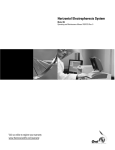
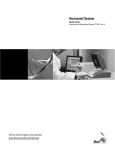

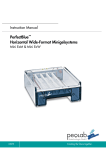
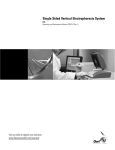
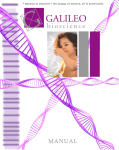
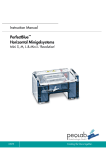
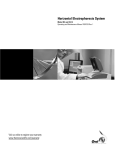
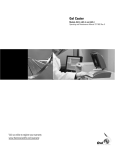
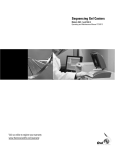
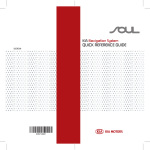

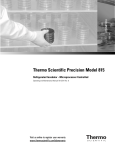

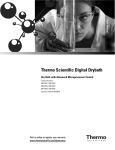

![TSD Series -40C ULT User Manual [EN]](http://vs1.manualzilla.com/store/data/005634658_1-66c9db561a67486106446026c707a26c-150x150.png)
